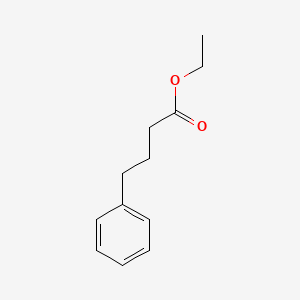Ethyl 4-phenylbutanoate
- Ethyl 4-phenylbutanoate
- 10031-93-3
- Ethyl 4-phenylbutyrate
- Benzenebutanoic acid, ethyl ester
- Ethyl 4-phenyl butyrate
- Create:2005-03-26
- Modify:2025-01-11

- Ethyl 4-phenylbutanoate
- 10031-93-3
- Ethyl 4-phenylbutyrate
- Benzenebutanoic acid, ethyl ester
- Ethyl 4-phenyl butyrate
- Benzenebutanoic Acid Ethyl Ester
- Ethyl benzenebutanoate
- Ethyl gamma-phenylbutyrate
- FEMA No. 2453
- UNII-BU9R7P5U55
- Butyric acid, 4-phenyl-, ethyl ester
- BU9R7P5U55
- MFCD00026923
- NSC-163318
- Ethyl .gamma.-phenylbutyrate
- AI3-34131
- 4-phenylbutyric acid ethyl ester
- DTXSID90143132
- 4-phenyl-butyric acid ethyl ester
- ETHYL 4-PHENYLBUTYRATE [FHFI]
- NSC 163318
- Ethyl 4-phenylbutanoate; Ethyl 4-phenylbutyrate; NSC 163318
- ethyl phenethyl acetate
- Ethyl 4-phenylbutanoate #
- SCHEMBL260297
- CHEMBL5193489
- DTXCID7065623
- FEMA 2453
- CHEBI:179907
- Butyric acid, 4-phenyl-ethyl ester
- AR3071
- BBL104183
- LMFA07010871
- NSC163318
- STL557997
- AKOS005216724
- CS-W010703
- AS-45517
- SY051383
- E1027
- NS00021426
- Q27274890
- Extracellular
- Membrane

H315 (100%): Causes skin irritation [Warning Skin corrosion/irritation]
H319 (100%): Causes serious eye irritation [Warning Serious eye damage/eye irritation]
H335 (100%): May cause respiratory irritation [Warning Specific target organ toxicity, single exposure; Respiratory tract irritation]
P261, P264, P264+P265, P271, P280, P302+P352, P304+P340, P305+P351+P338, P319, P321, P332+P317, P337+P317, P362+P364, P403+P233, P405, and P501
(The corresponding statement to each P-code can be found at the GHS Classification page.)
Patents are available for this chemical structure:
https://patentscope.wipo.int/search/en/result.jsf?inchikey=GGFNXKFGVQQNRV-UHFFFAOYSA-N
- Australian Industrial Chemicals Introduction Scheme (AICIS)Benzenebutanoic acid, ethyl esterhttps://services.industrialchemicals.gov.au/search-inventory/
- CAS Common ChemistryLICENSEThe data from CAS Common Chemistry is provided under a CC-BY-NC 4.0 license, unless otherwise stated.https://creativecommons.org/licenses/by-nc/4.0/Ethyl 4-phenylbutanoatehttps://commonchemistry.cas.org/detail?cas_rn=10031-93-3
- ChemIDplusEthyl 4-phenyl butyratehttps://pubchem.ncbi.nlm.nih.gov/substance/?source=chemidplus&sourceid=0010031933ChemIDplus Chemical Information Classificationhttps://pubchem.ncbi.nlm.nih.gov/source/ChemIDplus
- DTP/NCILICENSEUnless otherwise indicated, all text within NCI products is free of copyright and may be reused without our permission. Credit the National Cancer Institute as the source.https://www.cancer.gov/policies/copyright-reuse
- EPA DSSToxEthyl 4-phenyl butyratehttps://comptox.epa.gov/dashboard/DTXSID90143132CompTox Chemicals Dashboard Chemical Listshttps://comptox.epa.gov/dashboard/chemical-lists/
- European Chemicals Agency (ECHA)LICENSEUse of the information, documents and data from the ECHA website is subject to the terms and conditions of this Legal Notice, and subject to other binding limitations provided for under applicable law, the information, documents and data made available on the ECHA website may be reproduced, distributed and/or used, totally or in part, for non-commercial purposes provided that ECHA is acknowledged as the source: "Source: European Chemicals Agency, http://echa.europa.eu/". Such acknowledgement must be included in each copy of the material. ECHA permits and encourages organisations and individuals to create links to the ECHA website under the following cumulative conditions: Links can only be made to webpages that provide a link to the Legal Notice page.https://echa.europa.eu/web/guest/legal-noticeEthyl 4-phenylbutanoatehttps://echa.europa.eu/substance-information/-/substanceinfo/100.132.602Ethyl 4-phenylbutanoate (EC: 600-062-4)https://echa.europa.eu/information-on-chemicals/cl-inventory-database/-/discli/details/130398
- FDA Global Substance Registration System (GSRS)LICENSEUnless otherwise noted, the contents of the FDA website (www.fda.gov), both text and graphics, are not copyrighted. They are in the public domain and may be republished, reprinted and otherwise used freely by anyone without the need to obtain permission from FDA. Credit to the U.S. Food and Drug Administration as the source is appreciated but not required.https://www.fda.gov/about-fda/about-website/website-policies#linkingETHYL 4-PHENYL BUTYRATEhttps://gsrs.ncats.nih.gov/ginas/app/beta/substances/BU9R7P5U55
- Human Metabolome Database (HMDB)LICENSEHMDB is offered to the public as a freely available resource. Use and re-distribution of the data, in whole or in part, for commercial purposes requires explicit permission of the authors and explicit acknowledgment of the source material (HMDB) and the original publication (see the HMDB citing page). We ask that users who download significant portions of the database cite the HMDB paper in any resulting publications.http://www.hmdb.ca/citingEthyl 4-phenylbutanoatehttp://www.hmdb.ca/metabolites/HMDB0031618
- New Zealand Environmental Protection Authority (EPA)LICENSEThis work is licensed under the Creative Commons Attribution-ShareAlike 4.0 International licence.https://www.epa.govt.nz/about-this-site/general-copyright-statement/Benzenebutanoic acid, ethyl esterhttps://www.epa.govt.nz/industry-areas/hazardous-substances/guidance-for-importers-and-manufacturers/hazardous-substances-databases/
- ChEBIEthyl 4-phenylbutanoatehttps://www.ebi.ac.uk/chebi/searchId.do?chebiId=CHEBI:179907
- ChEMBLLICENSEAccess to the web interface of ChEMBL is made under the EBI's Terms of Use (http://www.ebi.ac.uk/Information/termsofuse.html). The ChEMBL data is made available on a Creative Commons Attribution-Share Alike 3.0 Unported License (http://creativecommons.org/licenses/by-sa/3.0/).http://www.ebi.ac.uk/Information/termsofuse.html
- EPA Chemical and Products Database (CPDat)Ethyl 4-phenyl butyratehttps://comptox.epa.gov/dashboard/DTXSID90143132#exposureEPA CPDat Classificationhttps://www.epa.gov/chemical-research/chemical-and-products-database-cpdat
- EU Food Improvement AgentsEthyl 4-phenylbutyratehttps://eur-lex.europa.eu/legal-content/EN/TXT/?uri=CELEX:32012R0872
- Joint FAO/WHO Expert Committee on Food Additives (JECFA)LICENSEPermission from WHO is not required for the use of WHO materials issued under the Creative Commons Attribution-NonCommercial-ShareAlike 3.0 Intergovernmental Organization (CC BY-NC-SA 3.0 IGO) licence.https://www.who.int/about/policies/publishing/copyrightETHYL 4-PHENYLBUTYRATEhttps://apps.who.int/food-additives-contaminants-jecfa-database/Home/Chemical/4825
- FDA Substances Added to FoodLICENSEUnless otherwise noted, the contents of the FDA website (www.fda.gov), both text and graphics, are not copyrighted. They are in the public domain and may be republished, reprinted and otherwise used freely by anyone without the need to obtain permission from FDA. Credit to the U.S. Food and Drug Administration as the source is appreciated but not required.https://www.fda.gov/about-fda/about-website/website-policies#linking
- Flavor and Extract Manufacturers Association (FEMA)ETHYL 4-PHENYLBUTYRATEhttps://www.femaflavor.org/flavor-library/ethyl-4-phenylbutyrate
- Japan Chemical Substance Dictionary (Nikkaji)
- LIPID MAPSLipid Classificationhttps://www.lipidmaps.org/
- Metabolomics WorkbenchEthyl 4-phenylbutanoatehttps://www.metabolomicsworkbench.org/data/StructureData.php?RegNo=44991
- NIST Mass Spectrometry Data CenterLICENSEData covered by the Standard Reference Data Act of 1968 as amended.https://www.nist.gov/srd/public-lawBenzenebutanoic acid, ethyl esterhttp://www.nist.gov/srd/nist1a.cfm
- SpectraBaseBenzenebutanoic acid, ethyl esterhttps://spectrabase.com/spectrum/1m8peMcGmmBenzenebutanoic acid, ethyl esterhttps://spectrabase.com/spectrum/JF6bCUqSgpr4-PHENYLBUTYRIC ACID, ETHYL ESTERhttps://spectrabase.com/spectrum/945HnZ53dNj4-PHENYLBUTYRIC ACID, ETHYL ESTERhttps://spectrabase.com/spectrum/Dt4HPPOKbMp4-Phenylbutyric acid, ethyl esterhttps://spectrabase.com/spectrum/4zmzs1pWPT2Ethyl 4-phenylbutyratehttps://spectrabase.com/spectrum/9EsAB9ckP3i
- Springer Nature
- SpringerMaterials4-Phenyl-butyric acid ethyl esterhttps://materials.springer.com/substanceprofile/docs/smsid_dhgcpjmvucheyumt
- Thieme ChemistryLICENSEThe Thieme Chemistry contribution within PubChem is provided under a CC-BY-NC-ND 4.0 license, unless otherwise stated.https://creativecommons.org/licenses/by-nc-nd/4.0/
- Wikidataethyl 4-phenyl butyratehttps://www.wikidata.org/wiki/Q27274890
- PubChem
- GHS Classification (UNECE)GHS Classification Treehttp://www.unece.org/trans/danger/publi/ghs/ghs_welcome_e.html
- NORMAN Suspect List ExchangeLICENSEData: CC-BY 4.0; Code (hosted by ECI, LCSB): Artistic-2.0https://creativecommons.org/licenses/by/4.0/NORMAN Suspect List Exchange Classificationhttps://www.norman-network.com/nds/SLE/
- MolGenieMolGenie Organic Chemistry Ontologyhttps://github.com/MolGenie/ontology/
- PATENTSCOPE (WIPO)SID 403431460https://pubchem.ncbi.nlm.nih.gov/substance/403431460

